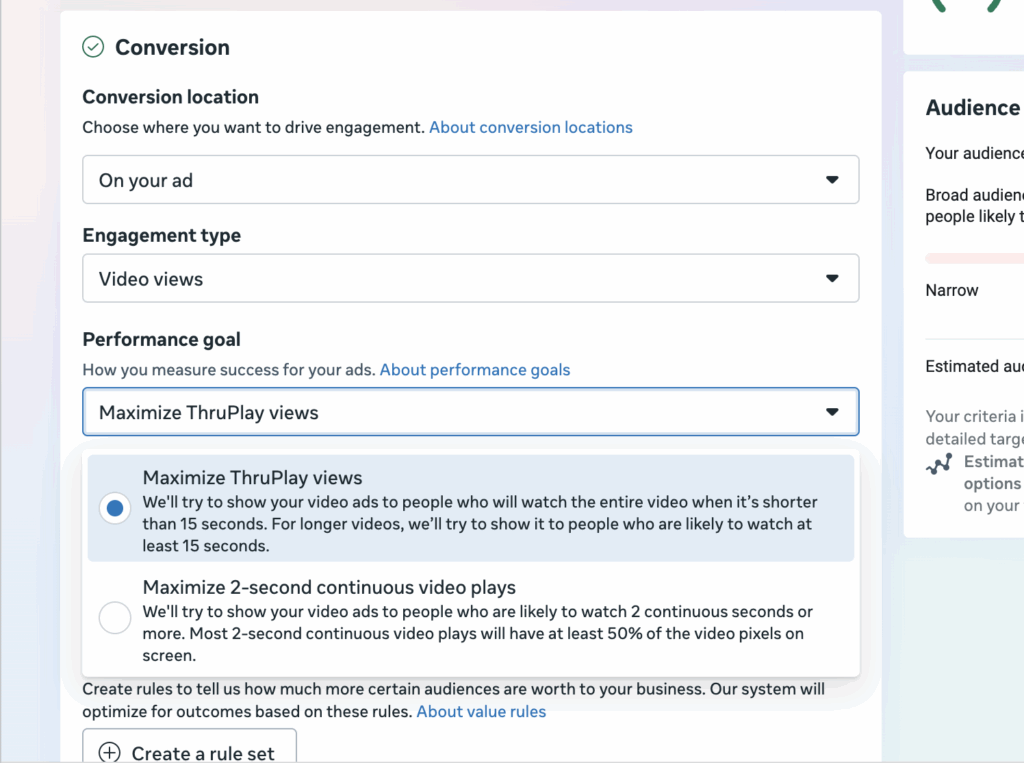- When Facebook Video Views Ads Fail
- When the Video Views Objective Is the Right Choice
- Pros and Cons of Video Views Ads
- Why Other Objectives May Be a Better Fit
- Best Ad Objective for a Video Views Campaign
- Correct Performance Goal for Video Views Campaigns
- How to Set Up a Video Views Campaign (Step-by-Step Tutorial)
- Best Practices You Can’t Afford to Miss
- Conclusion
Have you ever run a Facebook video campaign and felt disappointed by the results? You’re not alone. Many advertisers dive into video views campaigns expecting viral reach or conversions, only to discover that the results don’t always match the hype. In 2025, Meta has made several changes to its platform—and understanding when and how to use the Video Views objective has never been more important.
In this guide, we’ll explore the scenarios where Video Views ads shine, when they fall short, how to set them up correctly, and which performance goals truly matter. Whether you’re experimenting with short-form content or building top-of-funnel audiences for future retargeting, this guide is your starting point for mastering Video Views campaigns.
When Facebook Video Views Ads Fail
Let’s get one thing straight: not all Facebook campaign objectives are created equal—and Video Views is no exception. Despite its name, using the Video Views objective doesn’t always result in meaningful video engagement or business impact.
Here’s when Video Views ads typically underperform:
- When you’re optimizing for conversions. If your goal is sales, leads, or app installs, this objective is unlikely to drive direct results.
- When your creative isn’t thumb-stopping. A video that doesn’t grab attention within the first 2 seconds will be scrolled past, wasting impressions.
- When your audience targeting is too narrow. Since the algorithm is optimized for cheap views, tight audience targeting can cause CPMs to spike.
- When you don’t retarget viewers. Views without follow-up engagement rarely drive long-term value.
In short: if you expect a Video Views campaign to behave like a sales conversion campaign, you’re setting yourself up for disappointment.
When the Video Views Objective Is the Right Choice
So, when does it actually make sense to use the Video Views objective? There are several valid scenarios where this campaign type can be incredibly strategic:
- Priming your audience for retargeting. A video views campaign can warm up cold audiences before launching conversion ads.
- Brand storytelling. If you’re building awareness or sharing your mission, video is a low-cost, high-reach format.
- Testing creatives. Need to see which version of your ad performs best? Video views can quickly and affordably help you gather data.
- Expanding reach. When paired with broad targeting, you can achieve massive reach at low cost per impression.
In these cases, Video Views campaigns are an essential part of a layered funnel strategy—not a standalone revenue driver.
Pros and Cons of Video Views Ads
Pros:
- Extremely low cost per view (CPV)
- Great for building custom audiences
- High reach with short-form video
- Allows for testing creatives quickly
Cons:
- Not optimized for clicks or conversions
- View metrics can be misleading (e.g. 2-second views)
- Doesn’t drive meaningful engagement by default
- Not ideal for direct-response campaigns
Before choosing this objective, ask yourself: “Do I want views, or do I want actions?” If your answer is “actions,” there may be better options.
Why Other Objectives May Be a Better Fit
Video content isn’t limited to just the Video Views objective. Depending on your campaign goals, you might be better off using one of the following:
- Engagement Objective: If you want likes, shares, comments, or people clicking “Watch More,” this is often more effective.
- Traffic Objective: Better for sending people to a landing page after watching.
- Conversions Objective: Ideal if your goal is purchases or sign-ups.
- Leads Objective: Use this if you want to collect emails directly from the platform.
- Sales Objective: For campaigns with pixel-based optimization and end-to-end funnel tracking.
Choosing the wrong objective can sabotage your results—even if your video content is strong.
Best Ad Objective for a Video Views Campaign
Still convinced that the Video Views campaign is right for you? Then let’s talk about the Engagement Objective—because it might be your best option.
In 2025, the Engagement Objective under Meta’s updated structure allows you to drive not only views, but also valuable user interactions like shares, reactions, and longer watch times. It’s particularly useful if your video is longer than 30 seconds or designed to start conversations.
The Engagement Objective also opens the door to remarketing audiences, like people who watched at least 25%, 50%, or 75% of your video—giving you more leverage for future campaigns.
Correct Performance Goal for Video Views Campaigns
Once you’ve selected your campaign objective, setting the right performance goal is critical.
There are two primary optimization goals for video campaigns:
- ThruPlay: Optimizes for people likely to watch at least 15 seconds or to the end of your video—whichever is shorter. This is ideal for longer videos or when storytelling is important.
- 2-Second Continuous Video Play: Optimizes for users who will watch for at least 2 seconds without interruption. Use this if you’re promoting ultra-short content or just need a quick brand touchpoint.
Pro tip: If your content is under 15 seconds, ThruPlay and 2-second views may yield similar results—but always test both when in doubt.
How to Set Up a Video Views Campaign (Step-by-Step Tutorial)
Ready to launch? Here’s a basic walk-through to setting up your campaign the right way.
- Go to Ads Manager and click “+ Create.”
- Choose your Objective: Start with either “Engagement”.

- Set your Performance Goal: Select either ThruPlay or 2-second views.

- Define your Audience: Broad is usually best for scaling, but test interest targeting if needed.
- Choose your Placements: Auto placements generally work best. Remove Audience Network if video completion matters.
- Upload your Creative: Vertical video (9:16) performs better across Stories, Reels, and mobile Feeds.
- Write clear copy: Make your first 125 characters count—most people won’t click “Read More.”
- Launch and Monitor: Watch your CPV, ThruPlays, and audience retention curves to gauge performance.
Best Practices You Can’t Afford to Miss
A good Video Views campaign requires more than just uploading a video and hitting “Go.” Here are some best practices to follow in 2025:
- Front-load the value. The first 3 seconds determine whether someone keeps watching—start strong.
- Use captions. Most users watch with the sound off. Captions can increase watch time by over 25%.
- Optimize for mobile-first. Use vertical video, fast cuts, and on-screen text.
- Don’t run cold forever. Retarget engaged viewers with conversion-focused ads.
- Refresh creatives often. Fatigue sets in quickly—especially with short-form content.
- Use video retention graphs inside Ads Manager to see where viewers drop off.
Conclusion
Running a Facebook Video Views campaign in 2025 can be powerful—but only if you approach it strategically. Too often, advertisers waste budget on views that don’t translate to impact. By understanding when to use this objective, setting the right performance goals, and following platform-specific best practices, you can unlock real value from your video content.
Whether you’re building top-of-funnel awareness or creating remarketing audiences for future sales, video still matters. Just make sure you’re optimizing for the right outcomes—and not just empty view counts.
Ready to take your Facebook video ads to the next level? Stay tuned to our updates on Transcend Digital.



